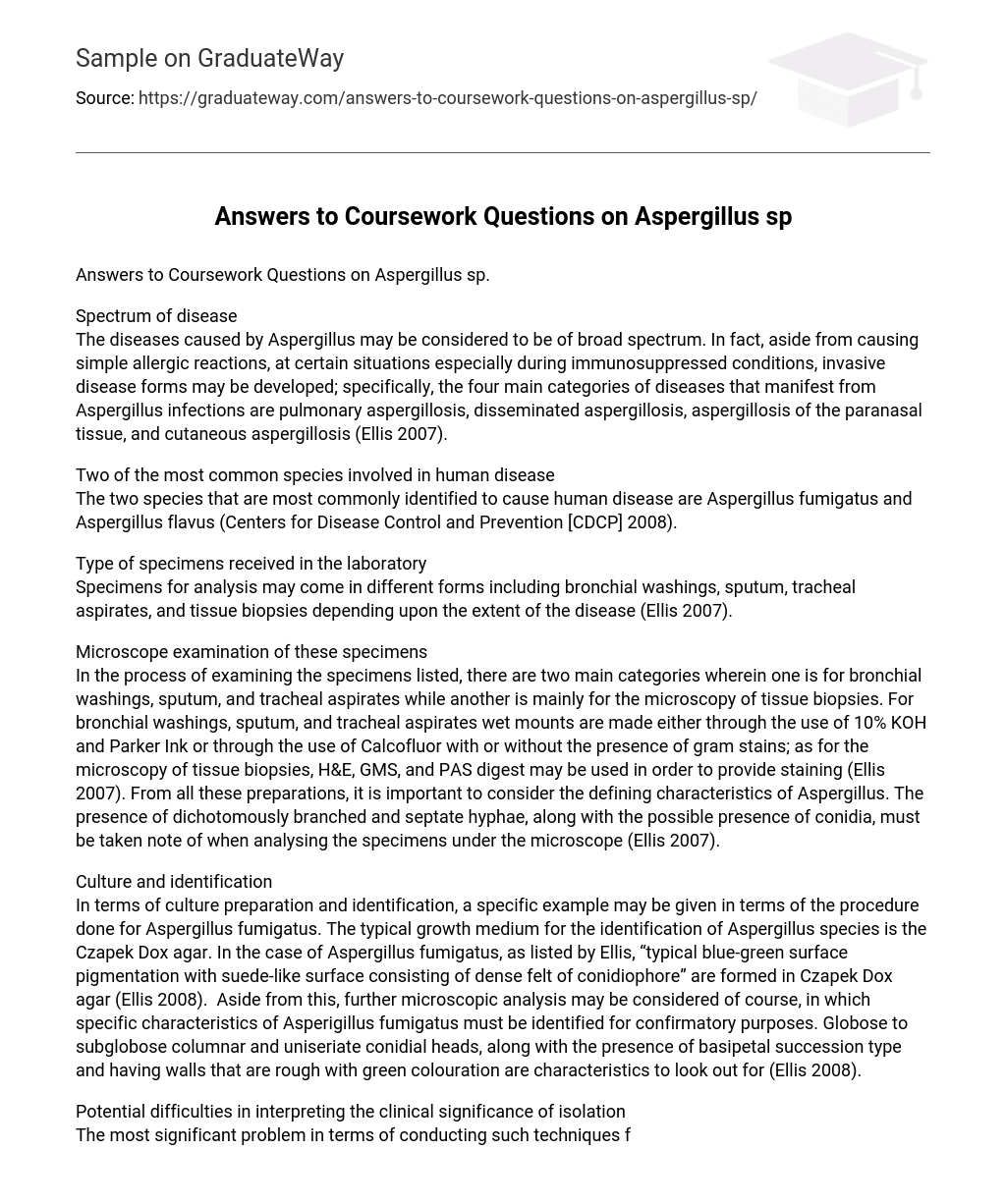Spectrum of disease
The diseases caused by Aspergillus may be considered to be of broad spectrum. In fact, aside from causing simple allergic reactions, at certain situations especially during immunosuppressed conditions, invasive disease forms may be developed; specifically, the four main categories of diseases that manifest from Aspergillus infections are pulmonary aspergillosis, disseminated aspergillosis, aspergillosis of the paranasal tissue, and cutaneous aspergillosis (Ellis 2007).
Two of the most common species involved in human disease
The two species that are most commonly identified to cause human disease are Aspergillus fumigatus and Aspergillus flavus (Centers for Disease Control and Prevention [CDCP] 2008).
Type of specimens received in the laboratory
Specimens for analysis may come in different forms including bronchial washings, sputum, tracheal aspirates, and tissue biopsies depending upon the extent of the disease (Ellis 2007).
Microscope examination of these specimens
In the process of examining the specimens listed, there are two main categories wherein one is for bronchial washings, sputum, and tracheal aspirates while another is mainly for the microscopy of tissue biopsies. For bronchial washings, sputum, and tracheal aspirates wet mounts are made either through the use of 10% KOH and Parker Ink or through the use of Calcofluor with or without the presence of gram stains; as for the microscopy of tissue biopsies, H&E, GMS, and PAS digest may be used in order to provide staining (Ellis 2007).
From all these preparations, it is important to consider the defining characteristics of Aspergillus. The presence of dichotomously branched and septate hyphae, along with the possible presence of conidia, must be taken note of when analysing the specimens under the microscope (Ellis 2007).
Culture and identification
In terms of culture preparation and identification, a specific example may be given in terms of the procedure done for Aspergillus fumigatus. The typical growth medium for the identification of Aspergillus species is the Czapek Dox agar. In the case of Aspergillus fumigatus, as listed by Ellis, “typical blue-green surface pigmentation with suede-like surface consisting of dense felt of conidiophore” are formed in Czapek Dox agar (Ellis 2008).
Aside from this, further microscopic analysis may be considered of course, in which specific characteristics of Asperigillus fumigatus must be identified for confirmatory purposes. Globose to subglobose columnar and uniseriate conidial heads, along with the presence of basipetal succession type and having walls that are rough with green colouration are characteristics to look out for (Ellis 2008).
Potential difficulties in interpreting the clinical significance of isolation
The most significant problem in terms of conducting such techniques for isolation and interpreting the results is that not all types of procedures lead to the same accuracy and reliability in terms of results. As a matter of fact, in cases wherein invasive pulmonary disease variants are developed, the detection of Aspergillus derived from simpler forms of sampling such as sputum is often a false negative; in this sense, more invasive procedures are done as well which is mainly through tissue biopsies (Ellis 2007).
Aside from the fact that time is wasted in this aspect, possible confusion in terms of results may also develop. Another problem when assessing the significance of the results from the isolates is that contamination is likely if proper measures are not taken since Aspergillus from the air may contaminate the samples, again leading to false results (Ellis 2007).
List of References
- Centers for Disease Control and Prevention (2008) Disease Listing: Aspergillosis General Information [online] available from <http://www.cdc.gov/nczved/dfbmd/disease_listing/aspergillosis_gi.html> [11 June 2009]
- Ellis, D. (2007) Aspergillosis – Mycology Online [online] available from <http://www.mycology.adelaide.edu.au/Mycoses/Opportunistic/Aspergillosis/index.ht ml> [11 June 2009]
- Ellis, D. (2008) Aspergillus fumigatus – Mycology Online [online] available from <http://www.mycology.adelaide.edu.au/Fungal_Descriptions/Hyphomycetes_(hyaline)/Aspergillus/fumigatus.html> [11 June 2009]





